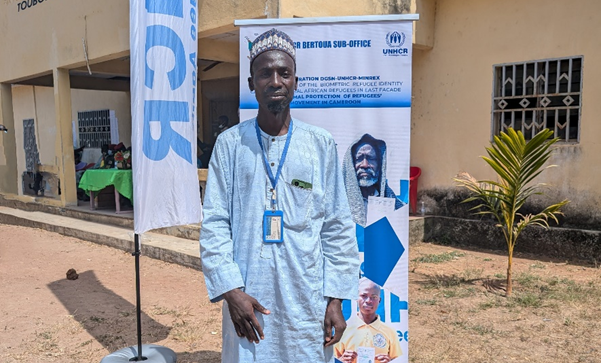The impact of biometric ID cards on refugees in Cameroon
Ali Bappaladane has been living in Cameroon for almost six years now. He is president of the refugee association in Mbaimboum, Far North region. Today, Ali joins a queue of excited refugees waiting to receive their government-issued biometric identity cards in Touboro, still in the Far North region.
Over 4000 of the 10,000 cards previewed are already printed and stacked on the tables, ready for distribution. “I hope my name is on the list,” says Ali. He must keep his composure and help coordinate the exercise, despite the excitement and commotion in the queues. Many have travelled more than 120 km on bumpy roads to attend the official card distribution ceremony.
Ali is eager to collect his card, as it symbolizes the Government of Cameroon’s welcome and protection of refugees. This initiative is a collaborative effort between Cameroon’s Ministry of External Relations (MINREX), the Directorate General of National Security (DGSN), and UNHCR, the UN Refugee Agency. At the heart of the initiative is UNHCR’s mandate to protect and support those forced to flee and the government’s efforts to ensure freedom of movement for refugees.

Ali Bappaladane, president of refugee association in Mbaimboum just before the distribution exercise in Touboro.
© UNHCR/Richard Atem
As the Government and UNHCR officials converged to commence the distribution of the biometric cards in Touboro, a similar exercise was launched in the capital city of Yaoundé. Here, urban refugees have just as much need for circulation, movement and or participation in the local economy, making the ID cards an absolute necessity.
HADIDJA, a Chadian refugee in Yaoundé, was among the first to arrive at the UNHCR and MINREX joint technical secretariat site in Bastos, where the distribution was planned to begin. She has recently enrolled at the prestigious Faculty of Medicine and Biomedical Sciences of the University of Yaoundé 1 (commonly referred to as CUSS) and hopes that the new ID card will facilitate access to financial and banking services or scholarships, especially as she aspires to further her education.
The introduction of biometric ID cards has had a profound impact on the refugee community in Cameroon. For many refugees, these cards are more than just identification; they are a gateway to a better life. Shelley Teckombi Yazembrou, a refugee from the Central African Republic, struggled for nearly seven years to open a bank account or move around freely without a national identity card. “Having the ID card has really helped me,” says Shelley. “I can move around freely without fear of arrest or harassment,” she adds.
“The move to create biometric cards for refugees, endorsed by the government, has been a long time in the making,” says UNHCR’s Head of Protection in Cameroon, Bettina Gambert. “Seeing the smiles on the faces of refugees when they receive their cards is testament to the collaboration between the Government of Cameroon and UN agencies. This is a sure step towards achieving the Sustainable Development Goals,” she added.
By providing biometric ID cards, the government and UNHCR are not only ensuring the protection and rights of refugees but also facilitating their inclusion into society. It is a step that will enable refugees to access essential services, open bank accounts, and participate more fully in Cameroon’s economic and social life.
As Ali and Hadidja receive their biometric ID cards, they are not just receiving a piece of plastic. They are receiving a symbol of hope, inclusion, and a brighter future. They are living proof of what can be achieved when governments and international organizations work together towards a common goal.
Source: UNHCR





